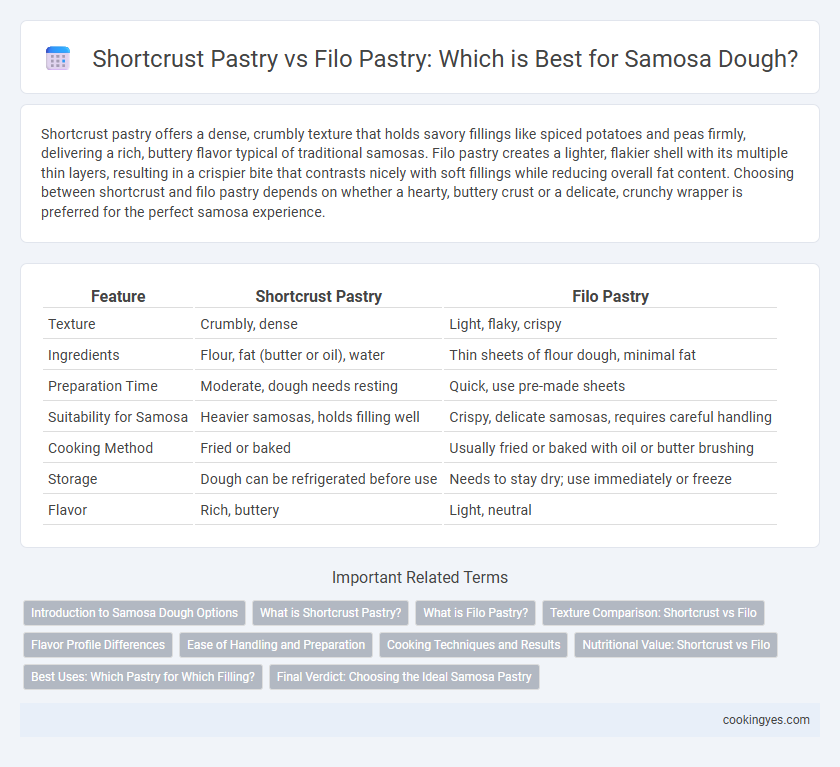Shortcrust pastry offers a dense, crumbly texture that holds savory fillings like spiced potatoes and peas firmly, delivering a rich, buttery flavor typical of traditional samosas. Filo pastry creates a lighter, flakier shell with its multiple thin layers, resulting in a crispier bite that contrasts nicely with soft fillings while reducing overall fat content. Choosing between shortcrust and filo pastry depends on whether a hearty, buttery crust or a delicate, crunchy wrapper is preferred for the perfect samosa experience.
Table of Comparison
| Feature | Shortcrust Pastry | Filo Pastry |
|---|---|---|
| Texture | Crumbly, dense | Light, flaky, crispy |
| Ingredients | Flour, fat (butter or oil), water | Thin sheets of flour dough, minimal fat |
| Preparation Time | Moderate, dough needs resting | Quick, use pre-made sheets |
| Suitability for Samosa | Heavier samosas, holds filling well | Crispy, delicate samosas, requires careful handling |
| Cooking Method | Fried or baked | Usually fried or baked with oil or butter brushing |
| Storage | Dough can be refrigerated before use | Needs to stay dry; use immediately or freeze |
| Flavor | Rich, buttery | Light, neutral |
Introduction to Samosa Dough Options
Samosa dough options mainly include shortcrust pastry and filo pastry, each offering unique textures and flavors. Shortcrust pastry provides a rich, buttery, and crumbly base that complements savory fillings, while filo pastry delivers a light, crispy, and flaky outer layer ideal for a delicate crunch. Choosing between these dough types depends on regional preferences and the desired balance between sturdiness and crispiness in the final samosa.
What is Shortcrust Pastry?
Shortcrust pastry is a type of dough made from flour, fat (usually butter or ghee), and water, known for its crumbly, tender texture that forms a sturdy yet delicate shell ideal for savory fillings like samosas. Unlike filo pastry, which is paper-thin and crisp, shortcrust pastry provides a denser, more buttery base that holds robust fillings without becoming overly flaky or breaking apart during frying or baking. Its ability to create a balanced, melt-in-the-mouth crust makes shortcrust pastry a popular choice for traditional samosa dough, enhancing both texture and flavor.
What is Filo Pastry?
Filo pastry is a paper-thin, unleavened dough made from flour, water, and a small amount of oil, commonly used in Middle Eastern and Mediterranean cuisines. Its delicate, crispy texture creates a light, flaky shell for samosas, contrasting with the denser, crumbly nature of shortcrust pastry. Filo pastry requires careful layering and brushing with oil or butter to achieve the characteristic crunch and golden color ideal for samosa wrappers.
Texture Comparison: Shortcrust vs Filo
Shortcrust pastry provides a denser, crumbly texture that gives samosas a rich, buttery bite, making it ideal for a more substantial filling. Filo pastry, by contrast, offers a crisp, flaky, and delicate layer that creates a lighter, crunchier experience with multiple thin sheets. Texture-wise, shortcrust is sturdy and robust, while filo delivers an airy, brittle crust that enhances contrast with savory fillings.
Flavor Profile Differences
Shortcrust pastry for samosas offers a rich, buttery flavor with a tender, crumbly texture that enhances the savory filling's heartiness. Filo pastry provides a lighter, crispier shell with a delicate, slightly nutty taste that allows the filling's spices to shine without overpowering them. Choosing between shortcrust and filo dough significantly impacts the samosa's overall flavor complexity and mouthfeel.
Ease of Handling and Preparation
Shortcrust pastry offers easier handling and preparation for samosa dough due to its pliable, non-fragile texture that resists cracking during rolling and folding. Filo pastry demands delicate layering and careful moisture control, making it more prone to tearing and requiring extra skill and time. Therefore, shortcrust pastry is preferred by home cooks seeking a straightforward, less time-consuming samosa-making process.
Cooking Techniques and Results
Shortcrust pastry yields a dense, crumbly samosa shell that holds fillings securely, ideal for deep frying to achieve a golden, crispy exterior. Filo pastry creates ultra-thin, flaky layers, resulting in a lighter texture with delicate crunch, best suited for baking or shallow frying to preserve its crispness. Cooking with shortcrust emphasizes sturdiness and richness, while filo pastry production focuses on layering and creating airy, crisp samosas.
Nutritional Value: Shortcrust vs Filo
Shortcrust pastry used for samosas tends to be higher in fat and calories due to the butter or shortening content, providing a richer taste but increased saturated fat. Filo pastry is significantly lower in fat and calories, as it is made from thin, unleavened dough layers with minimal oil, making it a lighter and healthier option. Nutritionally, filo pastry offers less cholesterol and total fat, making it preferable for calorie-conscious individuals seeking a crisp, flaky samosa.
Best Uses: Which Pastry for Which Filling?
Shortcrust pastry provides a rich, crumbly texture ideal for hearty or spiced samosa fillings like minced meat, vegetables, or lentils, as it holds moisture well without becoming soggy. Filo pastry, known for its thin, flaky layers, is best suited for lighter fillings such as cheese, spinach, or mildly spiced potatoes, offering a crisp, delicate bite that contrasts well with subtle flavors. Choosing the pastry depends on the filling's moisture and flavor intensity to achieve the perfect texture balance and overall samosa experience.
Final Verdict: Choosing the Ideal Samosa Pastry
Shortcrust pastry offers a crisp, sturdy texture that holds samosa fillings well, making it ideal for maintaining shape during deep-frying. Filo pastry provides a lighter, flakier crust that results in a delicate, crisp bite but requires careful handling due to its thinness and moisture sensitivity. The ideal samosa pastry depends on preference for texture and ease of preparation, with shortcrust favored for robustness and filo preferred for a lighter, more elegant finish.
Shortcrust pastry vs Filo pastry for samosa dough Infographic

 cookingyes.com
cookingyes.com